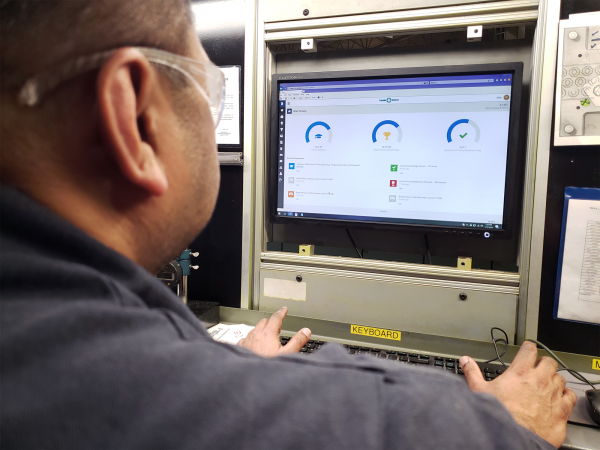
Q&A: Axonify’s Carol Leaman on how manufacturers can train via ‘micro-learning’
November 1, 2019
By
Kristina Urquhart

Manufacturing AUTOMATION: What gap were you filling in the market with Axonify?
Carol Leaman: We had an initial customer who was looking to dramatically change some business results from what employees were doing on the job.
The employees would get out in the field and they would do a whole bunch of things incorrectly, and it wasn’t until those things were very visible that they realized the extent of the loss. The client was looking for a way to change behaviour quickly and be able to tie that behaviour change to a measurable business outcome.
So we conceived of this idea that went 100 per cent against the way people were typically being trained in corporate enterprise, then we worked with that customer to roll it out. It worked to change behaviour and to get a business outcome for them, and we used that initial use case to then expand in many areas [including at Cambridge, Ontario manufacturer Precision Resource. For more on how Precision is using the platform, scroll to the bottom of this article.]
MA: What is the driving force behind the platform?
CL: It was this idea that corporate training is broken. The way we do it in corporate enterprise doesn’t make anybody remember anything. People are human and they do their best but when they don’t remember, they guess – and when you guess at things, you often will do them wrong, or you won’t do them at all. Both of those things result in an employer not maximizing their revenue potential or profit potential.
We’ve locked on a system that does, in fact, create memory very quickly, which changes the behaviour of the individual very quickly, and we can tie what they know and don’t know to the specific business objective the company is trying to achieve with knowledge.
MA: How does Axonify work?
CL: Instead of one long form, a boring classroom or online sessions – which are basically the ways people get trained – we decided that we would do something that was really fun, fast and personalized to each individual based on their demonstrated levels of knowledge in each topic area.
With Axonify, we built a really robust learning platform and algorithm that delivers a three- to five-minute-a-day experience of learning (“micro-learning”) that involves some gamification –like competitions with your co-workers – and it targets key pieces of knowledge to each individual every single day that are potentially different based on how they perform on the platform.
We built in cognitive science capabilities to ensure that [the platform] maps to how the brain works best to remember information.
MA: Can you give an example of how this training might be used in the manufacturing space?
CL: If you have a new employee, you can enrol them in all of the foundational training that they need to have before you send them out on the job. If somebody’s doing something dangerous, you can’t just go, “Oh you’re going to learn three minutes a day for the next month.” So they do the foundational stuff first, and then immediately get enrolled in all of the reinforcement modules. It’s that reinforcement that is critical to memory creation, long-term retention and the behaviour change.
MA: How does the platform use artificial intelligence to tailor training?
CL: Every single day, we collect millions of data points that come from what everybody is doing on the platform. The content the user sees has very granular levels. We ask questions so we know specifically what they know and don’t know. We also know who they are, what job they have, how long they’ve been enrolled in that topic, how long it took them to answer a question, how many times they’ve seen that question, and if they’ve gotten it right five times or wrong 10 times. If you collect 10 data points a day from 500 people, you’ve got 5,000 data points a day. Over a very short period of time, you end up with hundreds of thousands of data points. Then we marry the business outcomes.
Let’s say that you’re trying to reduce a particular kind of safety incident with a forklift that for some reason continues to happen in your manufacturing facility. We track the actual forklift accident, when it happened, what type of accident it is – and then, using the machine learning and AI, we look back automatically at who knew what in that topic area. We can then help our customers predict what their needs are – for example, if you don’t have enough people who know enough about forklift safety. Or if something is wrong in the content that you’re delivering around this topic area because it’s not mitigating those accidents.
We have had customers who find they are not actually training on the right things that are tied to that business result. Then they have to go back to rewrite the questions, because they’ve realized that the questions they’re asking and the training they’re giving is not effective.
Supervisors can see where [employees] are really struggling and then can address it. In some cases, people are guessing at questions and not actually learning anything, or in other cases the content is just really poor and it’s not well worded. There all kinds of things we can expose that manufacturers can take corrective action around.
MA: Would giving supervisors that level of information be concerning for the workers?
CL: We have not had a single customer that we’re aware of use it in any kind of punitive way. They genuinely want their people to be safer and more efficient and effective on the job.
MA: What are the biggest challenges in developing training solutions for manufacturers?
CL: There are several challenges. One is sometimes just access to training. There are many manufacturers who don’t allow cell phone use on the shop floor, or don’t have advanced machines that are Wi-Fi or web-enabled [the app requires an internet connection].
The other one is that it is a completely different way and mindset to train people, so sometimes you find pockets of resistance with employees or even with managers in plants saying you can’t expect somebody to spend three minutes in a shift doing something like this, playing a game and answering questions. It’s a leap of faith that this is an effective way to learn things. Once they get on the train and see the impact of it, we see that mindset shift, but there can be initial resistance.
MA: Why should manufacturers be evaluating their current methods of training?
CL: With the global landscape, it is so incredibly important for manufacturers to be able to compete effectively. They incur so much cost that results from lack of knowledge on the part of their workforce. Fortunately, advancements in technology and brain science are addressing the needs of the modern workforce, and also allowing those manufacturers to compete by providing them with skilled people. With the skills shortage being what it is, employers need to be thinking about how to continuously train so that they don’t fall behind and they don’t lose people.
This interview has been condensed and edited. It first appeared in the November/December 2019 issue of Manufacturing AUTOMATION. For more on how Precision Resource is using the platform, read below.
Case study: Precision Resource embraces micro-learning for training to reduce downtime
Cambridge, Ontario’s Precision Resource, a manufacturer specializing in stamping processes and secondary finishing components for the automotive and industrial sectors, had several challenges with its existing training program when it partnered with Axonify.
In order to reduce downtime, Precision Resource wanted to limit removing employees from the press shop floor for training – but the company also needed to keep up with job-specific training to ensure product quality and efficiency.
“Doing things right the first time, quickly and accurately, is key,” says Rob Graham, production manager at Precision Resource’s Cambridge Division. “Our goal is to produce the parts with the appropriate amount of labour, as quickly as we can, with no defects.”
Reducing downtime from improper training was another reason the company was searching for a new solution, says Graham, “If someone isn’t properly trained on how to run a press or use a particular tool and it’s damaged […] throughput comes to a grinding halt, which means we can’t produce parts the customer requires.”
Training in small doses
The company engaged Axonify to develop a new training platform that would deliver “micro-learning” to its employees – training sessions of three to five minutes a day that they can complete while on break or during quieter moments in a shift. Precision Resource also extended the platform beyond the press shop to its other departments including engineering and finance.
Precision Resource’s press shop employees have now been training on Axonify for more than 750 hours at three- to five-minute intervals during their shifts – all while the presses are running.
Improvements in knowledge
According to Jamie Brackpool, who is responsible for developing the employee training content used on the Axonify platform, “In the press shop alone, the value of that training is between $112,000 to $150,000 based on the time they get to train while the presses are actually running.”
Precision Resource is now able to accurately measure who knows what on the press shop floor and track the tangible impact of the training Brackpool delivers through the platform. Using the Axonify app’s artificial intelligence, training is personalized to each employee based on age, experience and rate of accuracy answering the questions.
Employees log on at least two or three times a week to do their training, averaging a 92 per cent participation rate, which has led to a 12 per cent increase in their knowledge in job-specific training, and health and safety topics.
“Being clear in showing people the correct way to do something and then making sure that training is reinforced with Axonify has really helped to decrease the amount of press operator errors,” says Graham.



